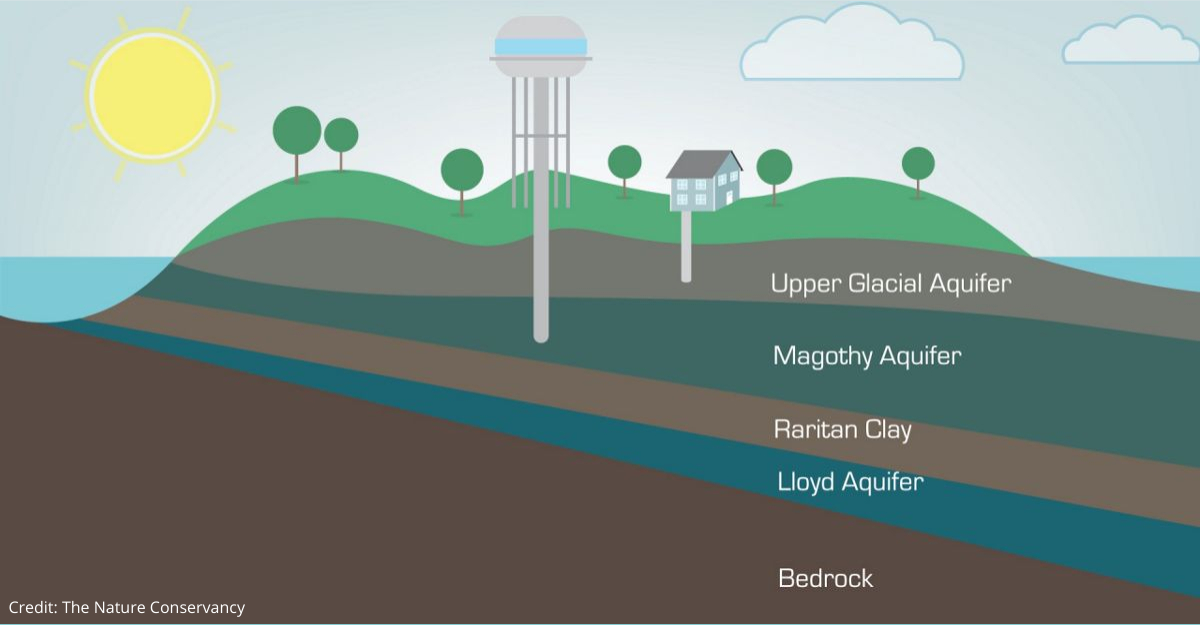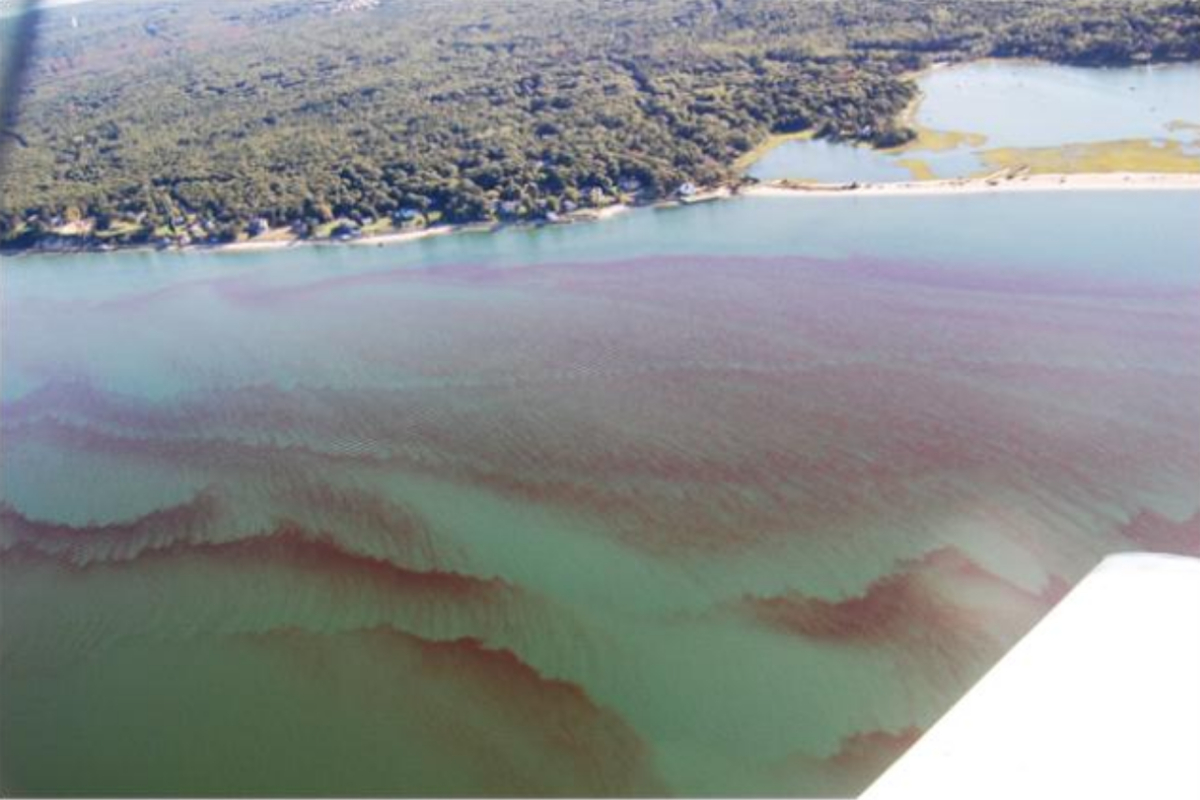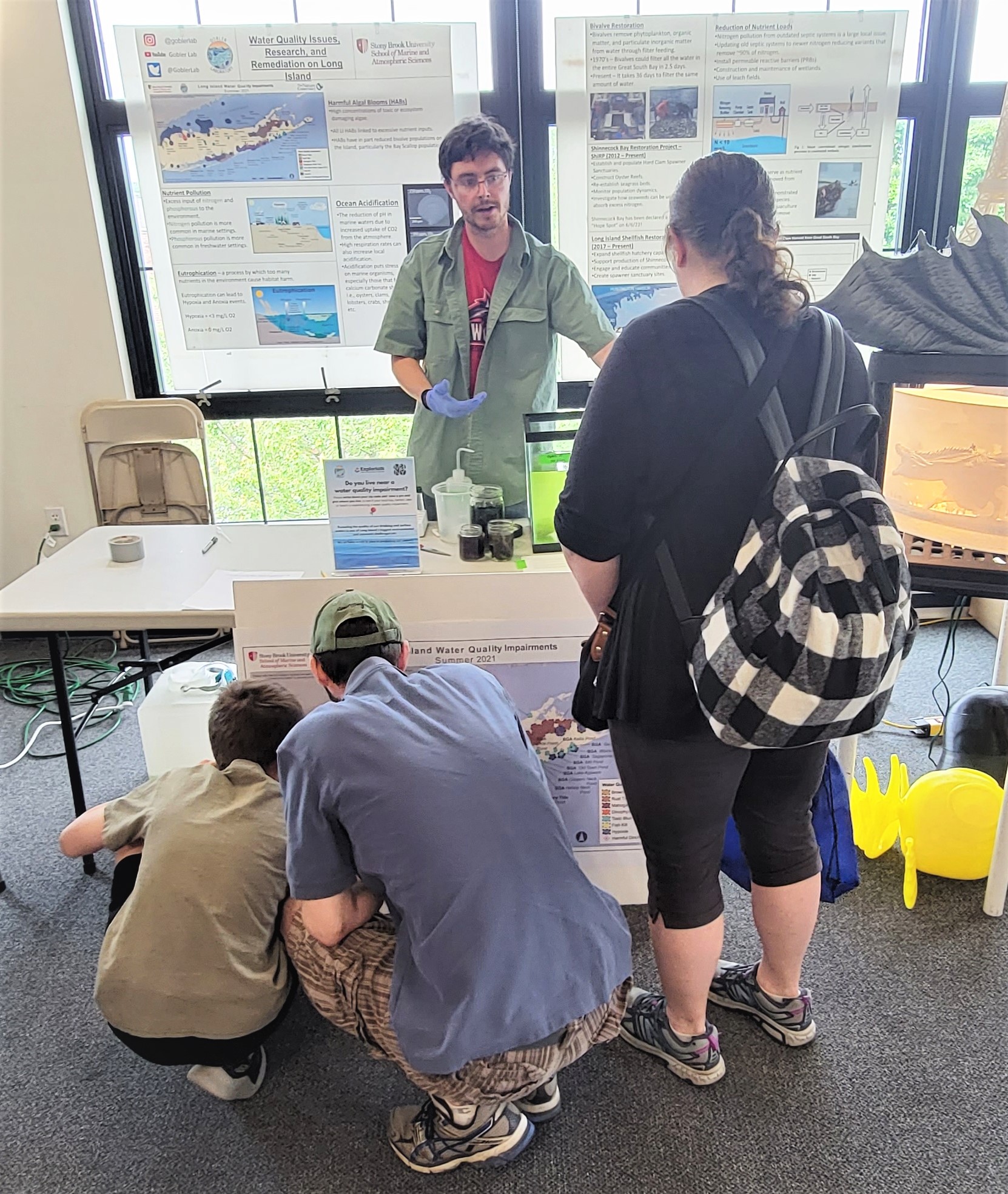
Supported by the Museum Association of New York, the Long Island Explorium is pleased to release this Long Island's Water Quality Resource Page.
"This page is intended to inspire the next generation of environmental stewards. We all have a role to play in protecting our waters."
This page uses water quality data from the Gobler Laboratory at Stony Brook University. We encourage site visitors to explore the page, the water quality map, and investigate what water quality issues that are present near your own home.
Where does your water come from?
Long Island is a federally-designated Sole Source Aquifer Region, meaning that 100% of our drinking water comes from one place - our aquifers. Aquifers are layers of underground rock and sediment that hold and store water. We drill down into these aquifers and extract water from the ground. These aquifers are recharged by precipitation (rainfall and snowfall). Our groundwater and surface waters also share a special connection. Water flows from our aquifers into our surface waters, like our bays, harbors, lakes, and streams.
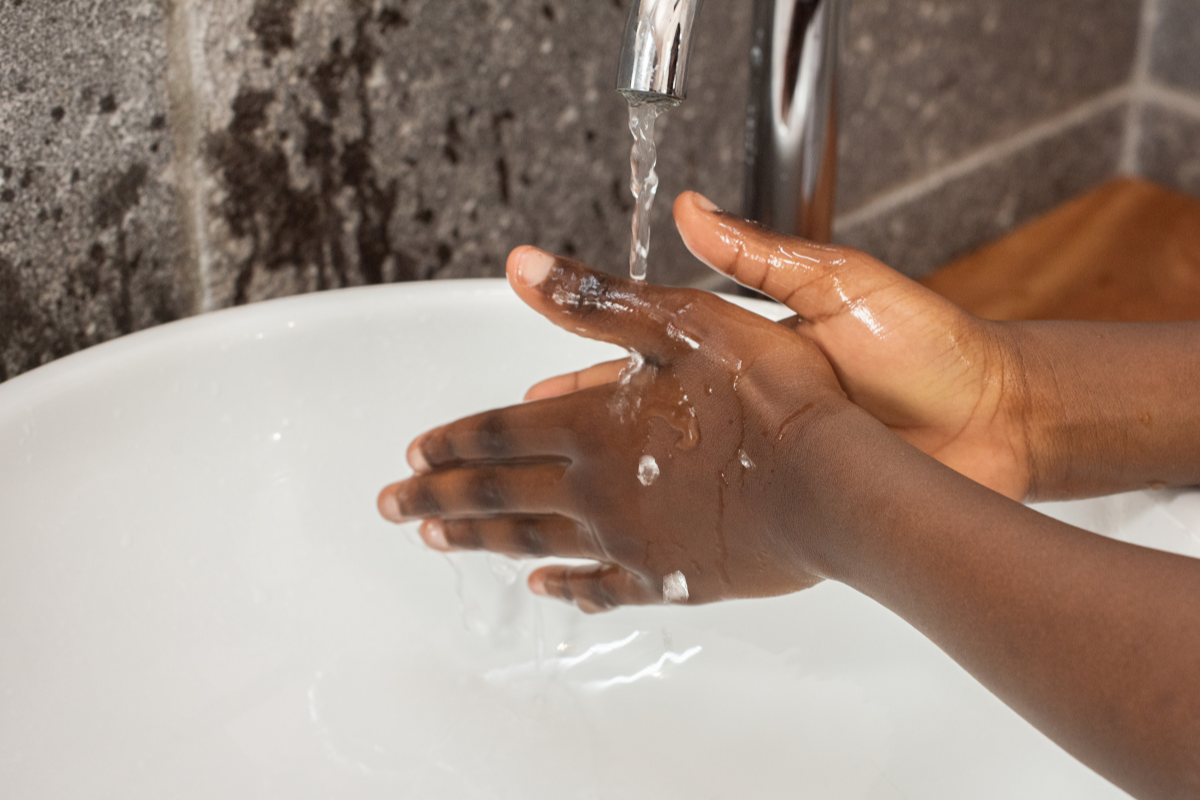
Where does your water come from?
Click to Flip and Find Out!
Answer:
When you wake up and head into the bathroom to wash your face or brush your teeth, where does that water come from? In areas around the United States, people get their drinking water from a variety of sources, like reservoirs, lakes, streams, and rivers. However, here on Long Island, we get our water from a special place - a system of underground aquifers right beneath our feet!
Everything we do on land, impacts our water quality
Since we live above our water supply, everything we do on land has the potential to impact our water quality. Everything we flush our toilets, pour down our drains, or put on our lawns can contaminate our water supply. Unfortunately, decades of science show that ground and surface water quality is declining. Nitrogen pollution from septic systems, cesspools and fertilizers, pesticides, and harmful chemicals are all being detected in our waters.
One of the most significant sources of pollution is nitrogen from septic systems and cesspools. In Suffolk County, in most cases, when we flush our toilets, that waste flows from our homes into a cesspool or septic system that sits in the ground. These systems were never designed to filter out nitrogen; therefore, our waste is ending in our water supply. There are more than 360,000 individual septic systems or cesspools in the ground on Long Island. Nitrogen flows from our homes and then into these systems that are leaching into our groundwater. The nitrogen then flows from our groundwater into our surface waters, where it causes many problems.
The excess nitrogen that ends up in our waters fuels the overgrowth of algae. These events are called “Harmful Algae Blooms” or HABs and are often referred to in the news by their color or appearance - red tide, brown tide, rust tide, etc.. Some of these blooms are toxic to marine life, humans and pets. As these algae blooms die, they also remove life-giving oxygen from the water, causing “dead zones.”

Video by The Nature Conservancy
Nitrogen pollution also weakens our salt marshes, which serve as our first line of defense against storm surge. Nitrogen in drinking water is also harmful to human health.
Water pollution is impacting our economy as well. Nitrogen in our waters has caused the collapse of our once-thriving shellfish industry. In addition, beaches and harbors are continuously closed across Long Island throughout the Summer, as a result of harmful algae blooms. This has resulted in a loss of industry and tourism dollars.
Other Pollutants
Other pollutants are being detected in our waters as well. Pesticides, harmful chemicals, pharmaceutical drugs, and personal care products are also polluting our ground and surface waters. We must pay careful attention to the personal care products we use and the chemicals we put on our lawns and pour down our drains.
Climate Change
Rising water and air temperatures are also having devastating impacts on our waters and marine life. Due to climate change, harmful algae blooms have been occurring more frequently and for longer periods of time. In addition, rising water temperatures are also responsible for shellfish die-offs.
Water Consumption
While it may seem like there is water all around us, only 2.5% of the world’s water is freshwater. We use freshwater, instead of saltwater, to drink with, bathe in, cook with and grow food with. We must use water wisely and make sure not to waste it, to ensure that there is water for future generations.
This map shows the many water quality impairments that occurred across Long Island in the Summer of 2022. The Gobler Lab at Stony Brook University monitors our waters and produces a new impairment map each year.
Restoring our water quality is one of the biggest environmental and economic challenges we face as Long Islanders! We all have a role to play in protecting our water quality.
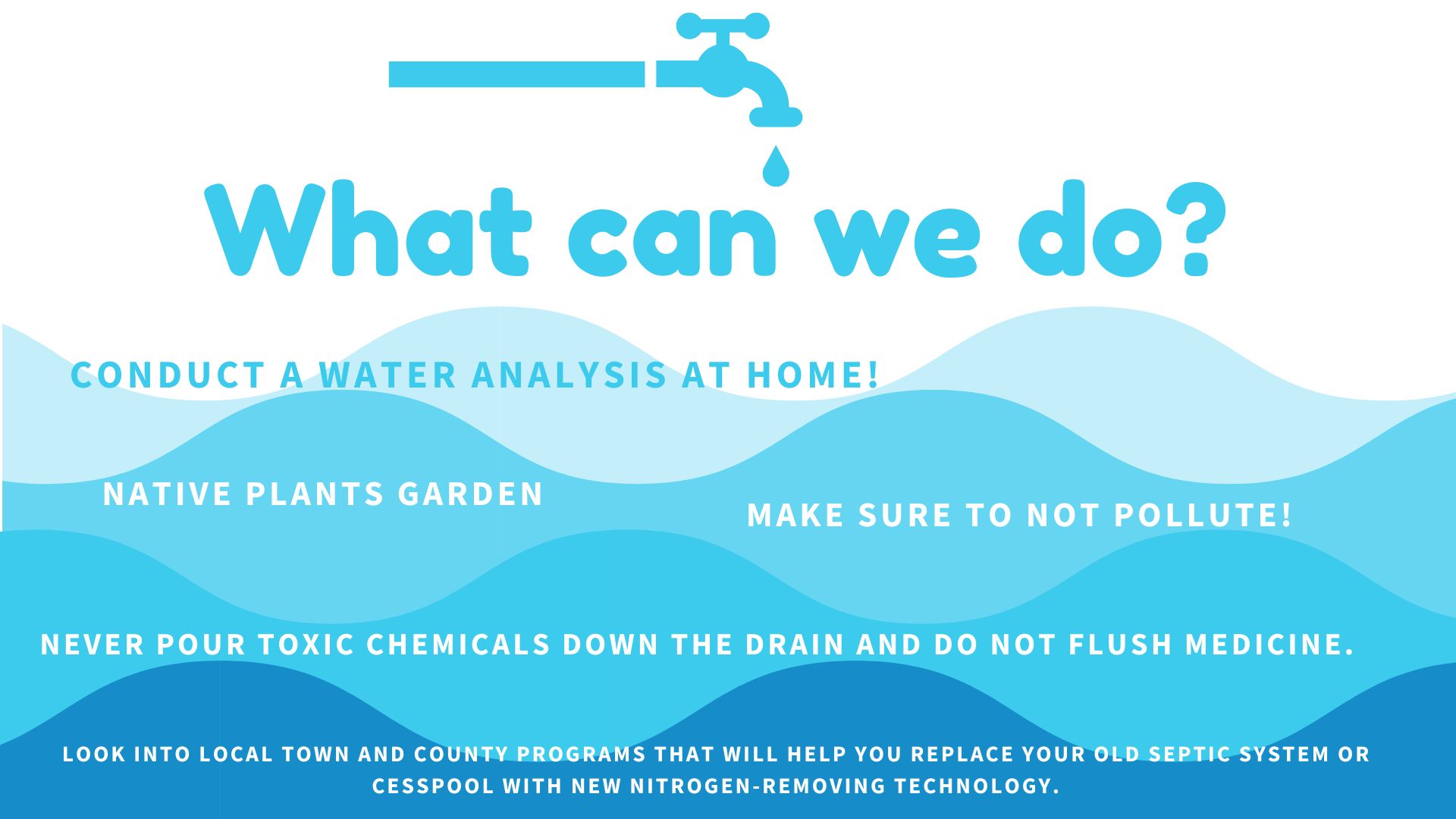
Click to learn more
Answer:
- Conduct a water analysis at home! Think about the many ways you use water throughout the day. Is there a way to reduce the amount of water to use? Are there natural alternatives you can use in your home instead of harmful chemicals? Calculate your water footprint here, to learn how much water your household uses and ways to reduce your water consumption.
- Make sure to not pollute! Pick up any trash or litter that you see and remember to always pick-up after your pet. Litter and waste can be carried away and end up in our waters.
- Never pour toxic chemicals down the drain and do not flush pharmaceutical drugs.
- Consider weeding naturally instead of applying pesticides. Also consider planting native plants in your garden. Learn more about Long Island Native Plants here or check out the Long Island Explorium’s Native Plant Garden!
- Consider installing a rain garden at home. Learn more here or make sure to visit the Long Island Explorium’s Rain Garden!
- Parents - look into local town and county programs that will help you replace your old septic system or cesspool with new nitrogen-removing technology. Check out Suffolk County’s Reclaim Our Water Program here.
Do you live near a water quality impairment?
At Maker Faire Long Island in June 2022, with support from the Gobler Lab, we asked visitors to plot where they live on the 2021 water quality impairment map. Visitors were able to check to see if their favorite beach, harbor, lake, river, or stream has been declared impaired. How is the water quality near you?
This webpage was produced with support from the Museum Association of New York (MANY).
Building a STRONGER tomorrow. Enriching and empowering lives through STEM.
Founded in 2005, the Long Island Explorium is committed to the development of programs and exhibits deeply rooted in research and evidence-based practice. Our programs are aligned with NYSSLS, ELA, Math, and Social Studies Standards.
The impact of the pandemic will be felt well into 2021 and beyond. We are counting on your continued investment in our mission to move forward. Your financial support will allow us to link adults, kids, and families together in ways illustrating that ideas, inspiration, hard work, and the failing-forward spirit result in amazing things.
For the past 15 years, we have burned a bright torch that illuminated the wonders, opportunities, and hope that science can hold for our future generations. The pandemic has dimmed our bright torch, but with your support, we look forward to burning brightly again and continuing to scale up our impact on all those who visit the Explorium and participate in our programs.
Please consider a donation to the Explorium by visiting our Support Page https://longislandexplorium.org/support-us/
Please view our Visit Us page to learn more about our reopening and enhanced protocols, https://longislandexplorium.org/visit-us/
Building a STRONGER tomorrow. Enriching and empowering lives through STEM.
Founded in 2005, the Long Island Explorium is committed to the development of programs and exhibits deeply rooted in research and evidence-based practice. Our programs are aligned with NYSSLS, ELA, Math, and Social Studies Standards.
The impact of the pandemic will be felt well into 2021 and beyond. We are counting on your continued investment in our mission to move forward. Your financial support will allow us to link adults, kids, and families together in ways illustrating that ideas, inspiration, hard work, and the failing-forward spirit result in amazing things.
For the past 15 years, we have burned a bright torch that illuminated the wonders, opportunities, and hope that science can hold for our future generations. The pandemic has dimmed our bright torch, but with your support, we look forward to burning brightly again and continuing to scale up our impact on all those who visit the Explorium and participate in our programs.
Please consider a donation to the Explorium by visiting our Support Page https://longislandexplorium.org/support-us/
Please view our Visit Us page to learn more about our reopening and enhanced protocols, https://longislandexplorium.org/visit-us/

